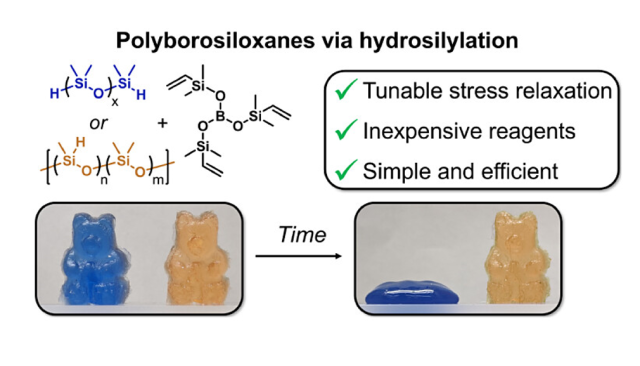
Facile Preparation of Tunable Polyborosiloxane Networks via Hydrosilylation
Colton A. D’Ambra, Patrick T. Getty, Taejun Eom, Michael Czuczola, Elizabeth A. Murphy, Souvagya Biswas, Allison Abdilla, Jodi M. Mecca, Thomas D. Bekemeier, Steven Swier, Alyssa Fielitz, Craig J. Hawker, and Christopher M. Bates
Chem. Mater. June 2024
Abstract: Polyborosiloxanes are used in a variety of fields due to their unique dynamic properties. Traditionally, cross-linked polyborosiloxanes are prepared by incorporating boric acid into siloxane prepolymers, a process that is time-consuming, energy intensive, and challenging due to reagent immiscibility. Here, we report a versatile synthetic method to rapidly cure polyborosiloxane networks via hydrosilylation of chain end or backbone functionalized polydimethylsiloxane (PDMS) derivatives with an inexpensive trivinylboronate. Networks synthesized from these readily available building blocks cure in ∼2 min at convenient temperatures (e.g., 90 °C) and exhibit enhanced viscoelastic behavior when compared to traditional polyborosiloxane networks fabricated via the conventional condensation route. By virtue of using efficient hydrosilylation chemistry, another key advantage of this synthetic platform is the ability to synthesize dynamic polyborosiloxanes with different network connectivity by simply using silicones with Si–H moieties placed at the chain ends (end-group) or distributed throughout the repeat-unit structure (pendant-group). The availability of other alkenes amenable to hydrosilylation provides an additional formulation handle to synthesize mixed dynamic–static networks with tunable control over stress relaxation and solvent resistance. In summary, the synthetic approach disclosed herein is a simple and accessible platform for preparing dynamic polyborosiloxanes with tunable material properties.